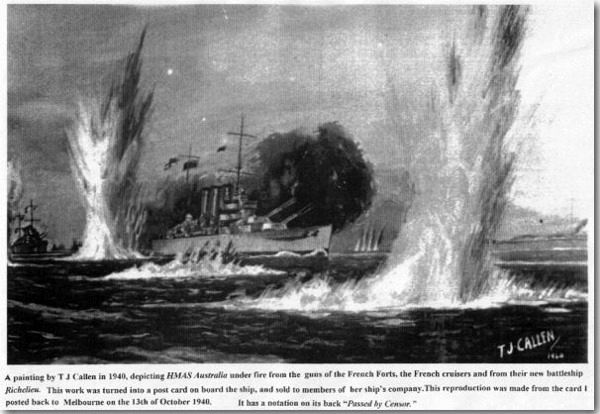- Author
- Gregory, Mackenzie J.
- Subjects
- Occasional papers, Naval Engagements, Operations and Capabilities, History - WW2, WWII operations
- Tags
-
- RAN Ships
- HMAS Australia II
- Publication
- December 1993 edition of the Naval Historical Review (all rights reserved)
Wednesday, 25th September 1940
Again off Dakar, and our slow `Walrus’ aircraft was catapulted at 0828.
The plan today – the battleship RESOLUTION would attack the RICHELIEU. The battleship BARHAM and cruiser DEVONSHIRE the forts, whilst we were to take on the two cruisers. Our `Walrus’ was spotting our fall of shot, and the Frenchmen retired behind a smoke screen. At one stage we were under fire from the RICHELIEU, the forts and both six inch cruisers. The French made use of an ingenious idea for spotting their shell bursts, each salvo was distinguished by a certain colour. RICHELIEU used yellow, the forts white, and the cruisers green and red.

Although the range was between 24 and 28,000 yards AUSTRALIA was twice hit by 6 inch shells. One passed under the rear of `X’ turret and exploded in the unmanned captain’s galley, which was wrecked, leaving a large hole in the deck but no one was injured. The second shell passed through the ship’s side on the port side, entered the engineer’s spare gear store, exploded – most of the shock was taken by the spare gear therein – but the armour belt was penetrated into the engine room, and the port distiller wrecked – no casualties. With an evaporator wrecked, fresh water was limited, and immediately rationed. If `X’ turret had not been trained forward, the first shell would probably have penetrated the gun house, and exploded with dire results.
Our aircraft had just reported our shells falling both sides of the French cruisers (meaning after our correction of range we would expect to hit) when it was observed to fall into the sea – shot down by a Curtiss fighter – in turn destroyed by fire from one of the battleships.
The cruisers and battleships withdrew. At this stage RESOLUTION was hit by a torpedo, and listed heavily to port. Destroyers now screened RESOLUTION – and a bomber attacked the crippled ship. We drove off this aircraft with accurate A/A fire.
We left the Dakar area, and AUSTRALIA screened RESOLUTION from her port quarter, and proceeded south at slow speed.
Difficulties of Operation at Dakar
I am now reporting my thoughts and opinions penned in my Midshipman’s Journal at that time; stated with all the wisdom of an eighteen-year-old.
In the first place, the force used was not adequate, and the Free French did not co-operate with the navy as they might have done.
They seemed to have poor intelligence, believing they had only to enter the town and all resistance would cease.
It was a shock to the Free French when they were fired on by their own countrymen – and they never recovered.
General de Gaulle did not wish his troops to fight their own kinsmen, so he withdrew.
In my opinion, given a total British force at our disposal, we would have achieved the objective. Bad visibility was against us – we had to close the forts to a short range.
A fort always had the upper hand in an action against ships – they have a fixed gun platform, are smaller in size, their fire control instruments are steady. It is likely the whole of Dakar harbour is gridded, so the forts know the exact range for each square on the harbour chart.
The RICHELIEU was a force we had not taken into account – she was used as a land battery, her new guns outranging the older guns of our battleships.
We operated in confined, and unknown waters. A bombardment in enclosed waters was a far greater task, than a ship to ship action in open waters.
The enemy bombers caused much trouble; the setback with using aircraft from carriers is that they are too slow.
The air arm fighters were not fast enough to overtake the `Martin’ bombers.
In my view we did not make use of the Fleet air arm bombers as extensively as they could have been used.
Dakar was defended by a greater number of troops than expected, and when the Free French would not fight very little could be achieved even with a successful bombardment.
We were given the wrong impression by the airmen’s signal `Success’ – from this fact de Gaulle thought Dakar was going to be his – this, however, was not to be.
Conclusion
France replied to the Dakar incident by bombing Gibraltar, and, as France said she would declare war on England if the Dakar episode was not closed – we had little alternative but to withdraw.
This port could only be taken with a large land force, and a powerful modern naval force and without Free French participation.

Vichy French inspect a shot-down Swordfish.
Aircraft from the Ark Royal did not have much success. In one attack, three Swordfish were lost.
This operation must be judged a failure on our side, a battleship badly damaged, 3 cruisers hit, one destroyer hit, and several aircraft lost.
On the other side, two destroyers and one unknown vessel were destroyed, two submarines out of action (1 sunk, 1 surrendered), two possible hits by 15 inch shells on the RICHELIEU, and a possible torpedo hit on one cruiser.
By removing two submarines, part of the menace to our shipping was removed – however, in the final analysis our ultimate objective was not achieved. AUSTRALIA had conducted herself with ability and the ship’s company could feel proud of their efforts.
NOTES:
- My Midshipman’s Journal was the source for this revisit to Dakar in 1991.
- All times use the naval 24 hour clock method.
REFERENCE:




